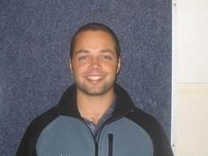Bragg-Grating-Based Rare-Earth-Ion-Doped Channel Waveguide Lasers And Their Applications
Promotion date: 22. November
Promotor: Prof.dr. Markus Pollnau
Assistant Promotor: Dr. Kerstin Wörhoff
| This research concerned the investigation and development of Bragg-grating-based integrated cavities for the Al2O3 waveguide platform, both from a theoretical and an experimental point of view, with the primary purpose of realizing narrow-linewidth, monolithic rare-earth-ion-doped channel waveguide lasers. Various rare-earth-ion-doped integrated channel waveguide lasers have been developed and demonstrated. These include an erbium-doped Al2O3 waveguide laser with a 1.7 kHz linewidth, as well as highly efficient ytterbium-doped Al2O3 lasers with slope efficiencies as high as 67%. Waveguide lasers have been used to generate stable microwave signals ranging between 12.43 GHz and 23.2 GHz, for use in phased array antennas. The stability performance and narrow-linewidth of these free-running lasers, show the great potential of using rare-earth-ion-doped monolithic waveguide lasers for the photonic generation of stable microwave signals. An innovative application of the photonic generation of stable microwave signals was the demonstration of an integrated intra-laser-cavity micro-particle optical sensor. It enables convenient, real-time detection and accurate size measurement of single micro-particles with diameters ranging between 1 μm and 20 μm, which represents the typical size of many fungal and bacterial pathogens. |
Was your thesis work theoretical or application driven?
I would say both aspects - fundamental issues as well as experiments towards a final application – were involved in my project. A theoretical description of the waveguide lasers was of utmost importance in order to determine the optimum design parameters. Once the design parameters were established, I could go to the cleanroom to develop and optimize the fabrication processes which were required. The main purpose of the project was to develop narrow-linewidth lasers to be used in phased array antenna systems.
Can you recall a special moment during your thesis project?
Thanks to the hard work by all the partners in the project, I managed to have nice results on a consistent basis. As a PhD student I was proud to receive an invitation to present my work at the recent Bragg-grating conference (BGPP) in the US, which was organized by the Optical Society of America.
The first nice moment was relatively early in the project when I succeeded in finishing a theoretical model, which formed one of the cornerstones for fabricating the waveguide lasers. Together with the great technicians at Mesa+ - bringing in their vast amount of knowledge and experience - we optimized the fabrication processes in the cleanroom. Characterizing the devices was an exciting experience, but it took some time before I understood all the measurement I had made.
Were some nice articles published?
I have had three publications in Optics Letters and one in Photonics and Nanostructures – Fundamentals and Applications, while another article is still in preparation.
How did you develop yourself, as a researcher and scientist?
As a master student in South Africa, I was mainly focussing on the theoretical aspects of solid-state lasers. Integrated optics was a completely new field for me when I started my PhD and I had to learn a lot. The cleanroom work was also new to me, but I have gained a great deal of experimental skills here at the Integrated Optical Microsystems (IOMS) group at Mesa+.
What are your future plans?
I have found a job at a well-established company here in the region. There are also many spinoff companies near the university, so there are many opportunities for recent graduates. I am excited about the new challenges which I will encounter in the industry now, as I don’t have any experience in this work field yet. I am looking forward to see how I can contribute to research in industry.
What, in your opinion, is important for Mesa+ to stay successful in future?
Cooperation and collaboration are some of the main advantages. At the annual Mesa+ day one is able to meet many potential colleagues. Also, the monthly Applied Nanophotonics meetings with the other optics-groups at the University of Twente, I perceived as very fruitful.
The emphasis on entrepreneurship is a strong characteristic of Mesa+ and the institute is known worldwide for this attribute. I think more attention could be given to regional awareness and achievements of this special institute, for example showing prospective students that they are much wanted to join the institute, in education and in research. There are many interesting ideas and topics for them to work on, waiting to be pursued by them.

